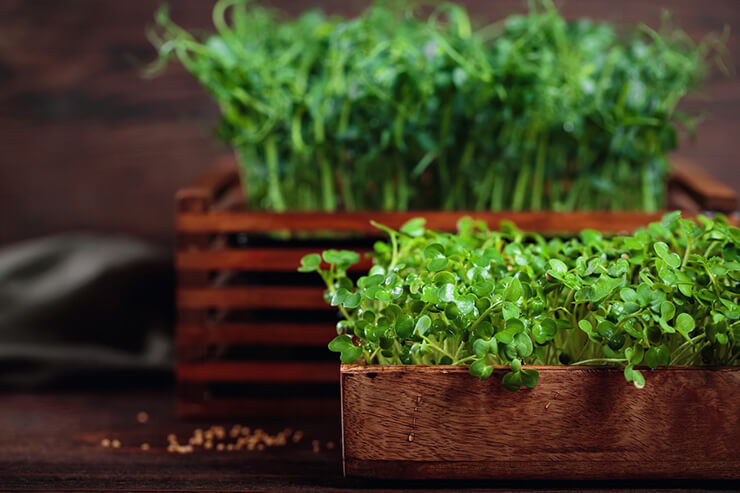Microgreens are the baby shoots of edible vegetables and herbs, harvested just after the cotyledons (seed leaves) and the first set of true leaves appear. Though tiny in size, these greens are bursting with flavor, nutrients, and visual appeal. Best of all? They’re incredibly easy and quick to grow indoors—no garden or deep container required.
Microgreens offer an ideal introduction to indoor gardening. Whether you’re short on space or time, these miniature greens can be grown in trays on a countertop, shelf, or sunny windowsill. Most varieties are ready to harvest in just 7-21 days, and they bring vibrant color and punchy taste to sandwiches, salads, and more.

Soil and pH Requirements
Microgreens don’t need a lot of soil, but they do appreciate a healthy, supportive base that allows their roots to grow quickly and evenly.
- pH Range:Aim for a pH between 0 and 6.5, which works well for most varieties.
- Growing Medium:Use a sterile, lightweight seed-starting mix or coconut coir. You can also experiment with hydroponic mats made of hemp, jute, or felt—no soil required!
- Nutrients:Because microgreens are harvested so young, they don’t need heavy fertilization. A rich seed-starting mix usually provides all the nutrition they need.
Light Requirements
Although they don’t need to mature fully, microgreens still require light to develop strong stems and vivid colors.
- Light Needs:Provide at least 10-12 hours of bright light daily. Without it, greens can become leggy and pale.
- Lighting Options:Full-spectrum LED grow lights are perfect and help ensure even, consistent growth. They can be suspended just 4-6 inches above the trays.
- Natural Light:If relying on sunlight, choose a bright windowsill with direct morning or afternoon sun. Rotate trays for uniform growth.
Watering Guidelines
Because microgreens grow quickly and densely, moisture management is key.
- Watering Frequency:Keep the soil evenly moist but not soggy. Most growers water once or twice a day depending on the environment.
- Method:Bottom watering is ideal—place trays in a shallow dish of water and let them soak for 15-30 minutes. This prevents damping-off and keeps leaves dry.
- Drainage:Always use trays with drainage holes if using soil. Good airflow also helps reduce mold risk.
Indoor Growing Environment
Microgreens don’t need fancy conditions—but they do love consistency.
- Temperature Range:A steady 65-75°F (18-24°C) is optimal for most varieties.
- Containers:Use shallow trays or recycled clamshell containers with drainage. No deep pots needed.
- Air Circulation:A small fan on a low setting will keep air moving and reduce the chance of mold.
- Harvesting:Cut microgreens with scissors just above the soil line when they’re about 2-3 inches tall and before the second set of leaves grows in.
5 Delicious Microgreen Options to Grow Indoors
Fast, flavorful, and fuss-free—microgreens are the perfect crop for indoor gardeners. They don’t require much space or time, and they deliver a fresh harvest year-round. With a wide range of colors, textures, and flavors, they add a gourmet touch to any meal.
Let’s explore five fantastic microgreens to grow indoors, along with their unique characteristics and popular culinary uses.
Radish Microgreens
These spicy little greens pack the same zesty punch as a full-grown radish, but in leafy form. They’re quick to germinate and are often ready to harvest in just 7-10 days.
Growing Highlights:
- Super-fast germination (often within 48 hours)
- Bold green leaves with red or purple stems
- One of the easiest microgreens for beginners
Tasty Uses:
- Add bite to tacos or grain bowls.
- Layer in sandwiches for a peppery crunch.
- Mix into egg dishes or omelets for flair and flavor.
Sunflower Microgreens
Sunflower microgreens are thicker and more substantial than most. With their nutty flavor and juicy texture, they’re often used as the base for microgreen salads.
Growing Highlights:
- Takes about 10-14 days to harvest
- Requires presoaking the seeds for best germination
- Grows tall and sturdy—fun to watch develop
Tasty Uses:
- Served as a fresh salad on their own
- Added to wraps and burgers
- Paired with citrus dressings or soft cheeses
Pea Shoots
Sweet, tender, and slightly grassy, pea shoots are popular for their crisp texture and curling tendrils. They bring a garden-fresh flavor that hints of sugar snap peas.
Growing Highlights:
- Usually ready in 10-14 days
- Best grown in deeper trays or containers
- Can regrow for a second harvest if cut above a leaf node
Tasty Uses:
- Stir-fried with sesame oil and garlic
- Layered into spring rolls or sandwiches
- Tossed with noodles or quinoa for added freshness
Broccoli Microgreens
These mild-tasting greens have a delicate crunch and are packed with nutrients, especially sulforaphane—a compound with antioxidant and anti-inflammatory benefits.
Growing Highlights:
- Grows well in as little as 8-10 days
- Thrives in shallow trays with fine-textured soil
- Great choice for sprouting beginners
Tasty Uses:
- Blended into green smoothies
- Sprinkled on avocado toast or hummus
- Added to soups just before serving
Red Cabbage Microgreens
With stunning purple stems and mild brassica flavor, red cabbage microgreens are both beautiful and health-boosting. They’re particularly rich in vitamins C and K.
Growing Highlights:
- Usually ready in 10-12 days
- Benefits from strong light to enhance color
- Grows best with bottom watering
Tasty Uses:
- Garnish for colorful slaws or rice bowls
- Mixed into chopped salads for crunch and color
- Used as a vibrant topping for fish or chicken


 Previous
Previous

